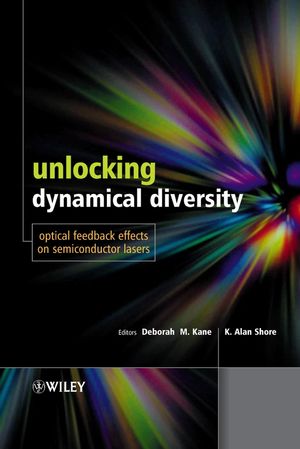Unlocking Dynamical Diversity: Optical Feedback Effects on Semiconductor LasersISBN: 978-0-470-85619-2
Hardcover
356 pages
April 2005
 This is a Print-on-Demand title. It will be printed specifically to fill your order. Please allow an additional 15-20 days delivery time. The book is not returnable.
|
||||||
List of Contributors xi
Preface xiii
Acknowledgements xv
1 Introduction 1
Deborah M. Kane and K. Alan Shore
1.1 Semiconductor Laser Basics 2
1.1.1 Semiconductor Laser Materials and Output Wavelengths 2
1.1.2 Semiconductor Laser Structures 4
1.1.3 Semiconductor Laser Gain and Output Power versus Injection Current 8
1.1.4 Semiconductor Laser Relaxation Oscillations, Noise, Modulation and Linewidth Enhancement Factor 11
1.2 Nonlinear Dynamical Systems 14
1.3 Semiconductor Lasers with Optical Feedback 15
1.4 Landmark Results: Theory and Experiment 17
1.5 Overview of Feedback Response: Regimes I–V 19
1.6 Outline of Applications 20
References 20
2 Theoretical Analysis 23
Paul Spencer, Paul Rees and Iestyn Pierce
2.1 Introduction 23
2.2 Basic Model: Single Mode Lasers with Weak Optical Feedback 24
2.3 Steady State Analysis of the Lang–Kobayashi Equations 27
2.4 Multimode Iterative Analysis of the Dynamics of Laser Diodes Subject to Optical Feedback 34
2.4.1 Dynamics of MultiMode Laser Diodes 34
2.4.2 Steady State Solutions 36
2.4.3 Comparison with Lang–Kobayashi Rate Equations 37
2.5 Cavity Length Effects 38
2.5.1 Long External Cavities 39
2.5.2 Short External Cavities 40
2.6 Coupled Cavity Analysis 44
2.6.1 Theory 45
2.6.2 Comparison with LK Analysis 49
2.6.3 Typical Results 49
2.7 Conclusion 53
References 53
3 Generalized Optical Feedback: Theory 55
Daan Lenstra, Gautam Vemuri and Mirvais Yousefi
3.1 Varieties of Optical Feedback 55
3.2 Compound-Cavity Analysis: Validity of Lang–Kobayashi Approach 58
3.3 Filtered Optical Feedback 62
3.3.1 External Cavity Modes 64
3.3.2 Dynamics 67
3.4 Phase-Conjugate Feedback 70
3.4.1 Steady State 71
3.4.2 Results of Stability Analysis for the Steady State 72
3.4.3 High-Frequency Oscillations 77
3.5 Conclusion 78
Acknowledgements 79
Note 79
References 79
4 Experimental Observations 81
A. Tom Gavrielides and David W. Sukow
4.1 Introduction 81
4.2 Experimental Apparatus 85
4.3 Extremely Weak Feedback Effects – Regime I 88
4.4 Very Weak Feedback Effects – Regime II 89
4.5 Weak Feedback Effects – Regime III–IV 93
4.6 Moderate Feedback Effects – Low Frequency Fluctuations 104
4.7 Short Cavity Regime 114
4.8 Double-Cavity Systems 117
4.9 Multimode Effects 119
4.10 Control 122
4.11 Feedback and Modulation 125
4.12 Phase Conjugate Feedback 133
4.13 Conclusion 139
References 140
5 Bifurcation Analysis of Lasers with Delay 147
Bernd Krauskopf
5.1 Introduction 147
5.2 Bifurcation Theory of DDEs 149
5.2.1 The Phase Space of a DDE 149
5.2.2 Local Bifurcations of Steady States 151
5.2.3 Local Bifurcations of Periodic Orbits 152
5.2.4 Unstable Manifolds and Global Bifurcations 153
5.3 Numerical Methods 155
5.3.1 Simulation by Direct Numerical Integration 155
5.3.2 Numerical Continuation 156
5.3.3 Computation of 1D Unstable Manifolds 157
5.4 Bifurcations in the COF Laser 158
5.4.1 Symmetry of the COF Laser Equation 159
5.4.2 External Cavity Modes 159
5.4.3 The Characteristic Equation of an ECM 161
5.4.4 Continuation Near Connecting Bridges 164
5.4.5 Global Bifurcations of ECMs 167
5.5 Bifurcations in the PCF Laser 169
5.5.1 Symmetry of the PCF Laser Equation 171
5.5.2 Bifurcation Diagram Near the Locking Region 171
5.5.3 Bifurcations of ECMs 175
5.5.4 Break-up of a Torus and Crisis Bifurcation 177
5.6 Conclusion 180
Acknowledgements 180
References 181
6 Chaos Synchronization 185
Siva Sivaprakasam and Cristina Masoller Ottieri
6.1 Introduction 185
6.2 Synchronization of Unidirectionally Coupled Semiconductor Lasers 187
6.3 Synchronization of Mutually Coupled Semiconductor Lasers 206
6.4 Conclusion 210
References 211
7 Laser Interferometry 217
Guido Giuliani and Silvano Donati
7.1 Introduction 217
7.2 Laser Diode Feedback Interferometry: Theory and Basic Experiments 218
7.2.1 Interferometric Signal 218
7.2.2 Semiconductor Laser Types and Signal-to-Noise Ratio 229
7.3 Application to Measurements 234
7.3.1 Displacement 234
7.3.2 Velocity 238
7.3.3 Vibration 240
7.3.4 Distance 243
7.3.5 Other Measurements and Developments 245
7.4 Laser Diode Diagnostics Using Self-Mixing Techniques 247
7.4.1 SL Linewidth Measurement 247
7.4.2 SL Linewidth Enhancement Factor Measurement 249
7.5 Conclusion 252
Acknowledgements 252
References 253
8 Single Frequency and Tunable Single Frequency Semiconductor Laser Systems 257
Esa Jaatinen
8.1 Introduction 257
8.1.1 Laser Mode Structure 258
8.1.2 Single Frequency Lasers 261
8.1.3 Frequency Tuning 262
8.2 Effect of Frequency Filtering the Feedback for Robust Single Frequency Operation 262
8.2.1 Spectrally Sensitive Cavity Elements 263
8.2.2 Interferometrically Filtered Feedback 264
8.2.3 Diffraction Grating Feedback 268
8.2.4 Multicomponent Feedback Systems 270
8.3 Tunable Semiconductor Laser System Designs and Operating Characteristics 272
8.3.1 External Cavity Diode Lasers 272
8.3.2 Tunable Monolithic Lasers 277
8.4 Frequency Stabilization 284
8.4.1 Comparison of Relative Effects of Different Stabilization Techniques 285
8.4.2 Improving Passive Frequency Stability with Temperature Controls 287
8.4.3 Improving Passive Frequency Stability with Current Controls 287
8.4.4 Improving Passive Frequency Stability with Stable Resonators 288
8.4.5 Active Frequency Stabilization with Optical Feedback 288
8.4.6 Active Frequency Stabilization with Relative Frequency References 289
8.4.7 Active Frequency Stabilization with Absolute Frequency References 291
8.5 Tunable Semiconductor Laser System Applications 292
8.5.1 Laser Absorption Spectroscopy 293
8.5.2 Saturated Absorption Spectroscopy 295
8.5.3 Optical Pumping 297
8.5.4 Raman Spectroscopy 297
8.5.5 Laser Cooling and Trapping of Particles 298
8.5.6 Optical Communications 299
8.5.7 Other Applications 301
8.6 Conclusion 301
References 301
9 Chaotic Optical Communication 307
Junji Ohtsubo and Peter Davis
9.1 Introduction 307
9.2 Communication Using Synchronized Laser Chaos 308
9.3 Methods for Modulation and Recovery of Messages 310
9.4 Mechanisms for Synchronization and Signal Recovery 317
9.5 Parameter Sensitivity, Robustness and Security for Synchronized Chaos Communication 322
9.6 Communication Bandwidth 325
9.7 Conclusion 330
Acknowledgements 331
References 331
Index 335



